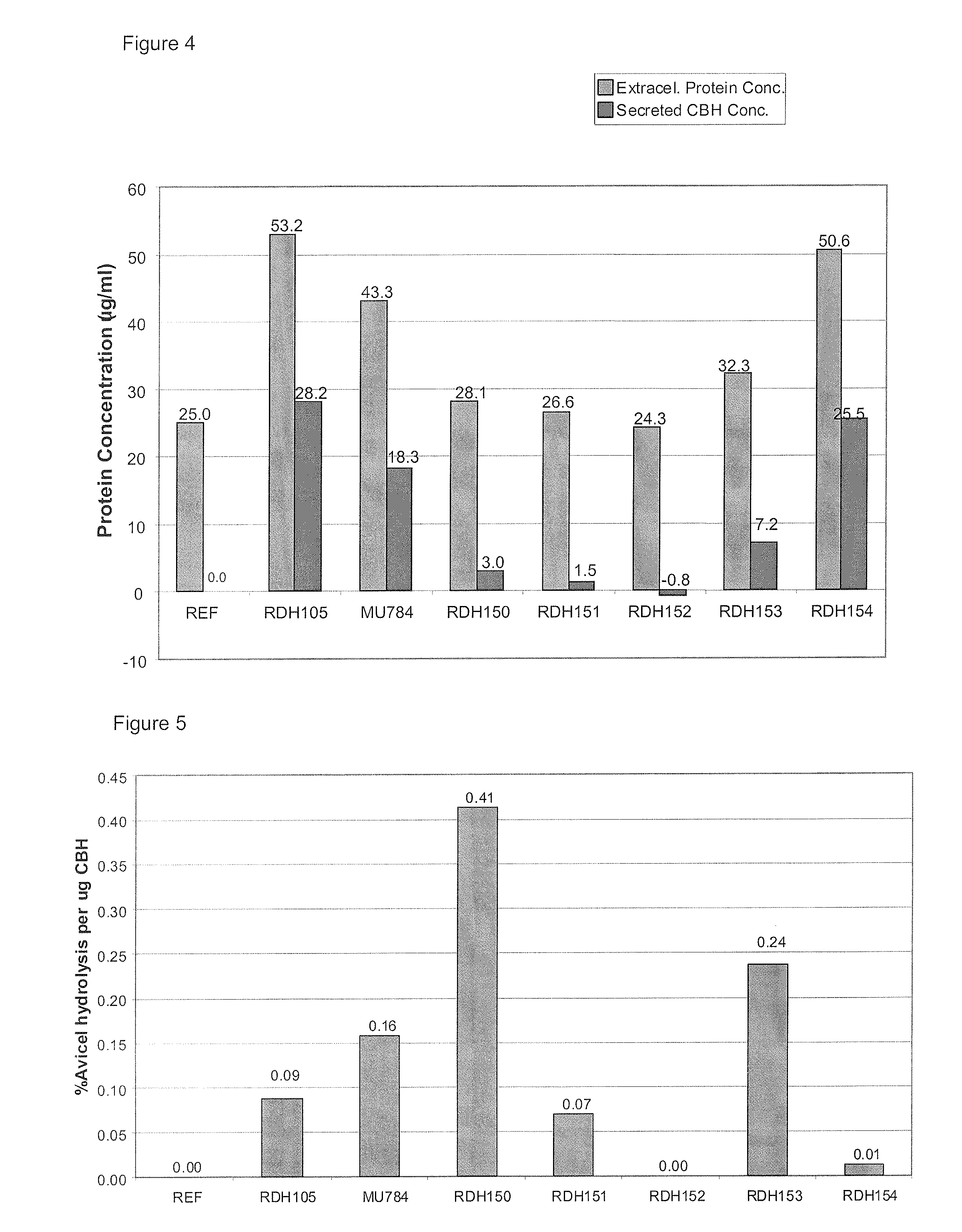Heterologous expression of fungal cellobiohydrolase 2 genes in yeast
a technology of fungal cellobiohydrolase and gene expression, which is applied in the field of heterologous expression of fungal cellobiohydrolase 2 genes in yeast, can solve the problems of inability to achieve amorphous cellulose fermentation, general absence of low-cost technology for overcoming the recalcitrance of these materials, and inability to achieve cellulose hydrolysis. , to achieve the effect of facilitating ethanol production and cellulose hydrolysis
- Summary
- Abstract
- Description
- Claims
- Application Information
AI Technical Summary
Benefits of technology
Problems solved by technology
Method used
Image
Examples
example 1
Cloning of Codon-Optimized Cbh2 Genes and their Expression in Saccharomyces cerevisiae
[0218]Cellobiohydrolase (cbh) genes from five fungal organisms (as indicated in Table 8 below) were selected for expression in yeast. The sequences were first codon-optimized for expression in Saccharomyces cerevisiae.
[0219]The software available on the website of the University of Maryland, Baltimore County applying the CAI codon usage table suggested by Carbone et al. 2003 was utilized to generate an initial sequence that had a codon adaptation index (CAI) of 1.0, where three-letter sequences encoding for individual amino acid codons were replaced with those three-letter sequences known to be most frequently used in S. cerevisiae for the corresponding amino acid codons. The initial codon-optimized sequence generated by this software was then further modified. In particular, the software was utilized to identify certain stretches of sequence (e.g., sequences with 4, 5, 6, 7, 8, 9, or 10 contiguo...
example 2
Avicel Hydrolysis in Yeast Expressing a Heterologous Cbh2
[0226]All strains were then tested for activity using the high-throughput Avicel conversion method using an Avicel concentration of 1% (or 10 g / L). The Dintrosalicylic Acid Reagent Soluction (DNS) used for the assay procedure contained phenol which, according to literature, renders greater sensitivity. Activity data can be seen in FIG. 3. From the activity data it is apparent that the strain expressing C. heterostrophus CEL7 (pRDH150) and V. volvacea CBHII-I (pRDH153) yielded appreciable amounts of activity on Avicel. The Piromyces sp. CEL6A-expressing strain also showed some activity.
example 3
Specific Activity of Cbh2s Expressed Heterologously in Yeast
[0227]To estimate the specific activity of the Cbh2s, the Bradford method (BioRad protein assay) was used as it is prescribed for microtiter plates, using the Gamma globulin standard. Supernatants samples were first subjected to the buffer exchange procedure as directed for the 2 mL Zeba desalt spin columns (Thermo Scientific). The amount of protein detected by the protein assay seemed to agree with what was seen on the SDS-PAGE.
[0228]The average amount of protein present in the REF strain samples was then subtracted from the amount of protein measured in the other samples to give an indication of the amount of heterologously expressed Cbh2 that was present in each sample (FIG. 4). Next, the specific activity of each CBH was estimated by dividing the activity (FIG. 3) by the amount of CBH present (FIG. 4) and expressed in “percentage degradation per μg protein” (FIG. 5). C. heterostrophus CEL7 (pRDH150) and V. volvacea CBHI...
PUM
| Property | Measurement | Unit |
|---|---|---|
| cell density | aaaaa | aaaaa |
| temperature | aaaaa | aaaaa |
| temperature | aaaaa | aaaaa |
Abstract
Description
Claims
Application Information
 Login to View More
Login to View More - R&D
- Intellectual Property
- Life Sciences
- Materials
- Tech Scout
- Unparalleled Data Quality
- Higher Quality Content
- 60% Fewer Hallucinations
Browse by: Latest US Patents, China's latest patents, Technical Efficacy Thesaurus, Application Domain, Technology Topic, Popular Technical Reports.
© 2025 PatSnap. All rights reserved.Legal|Privacy policy|Modern Slavery Act Transparency Statement|Sitemap|About US| Contact US: help@patsnap.com



